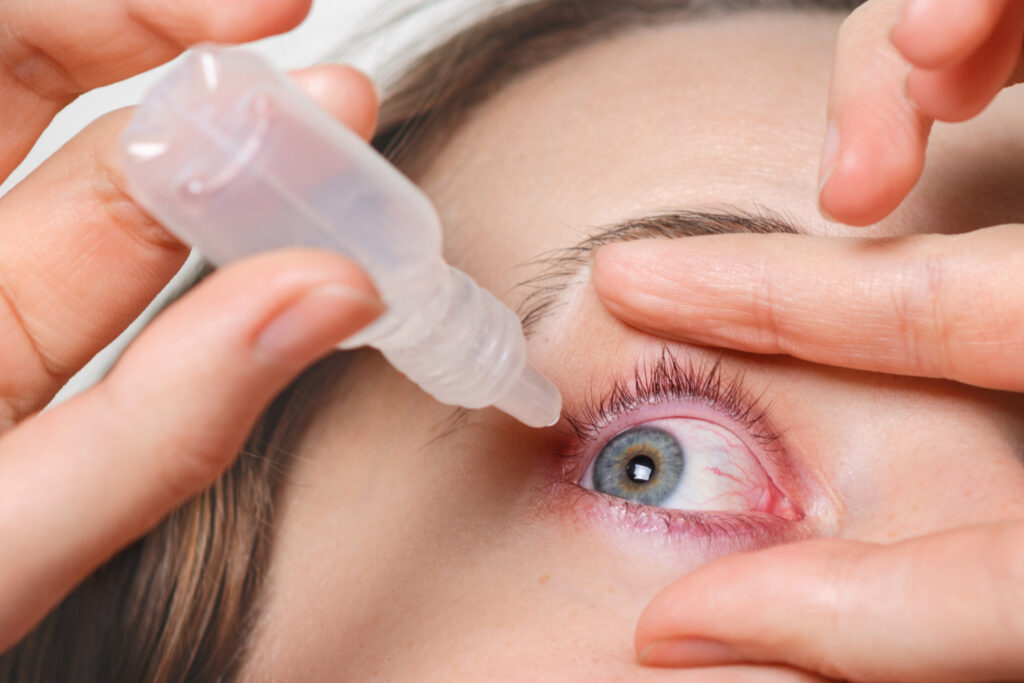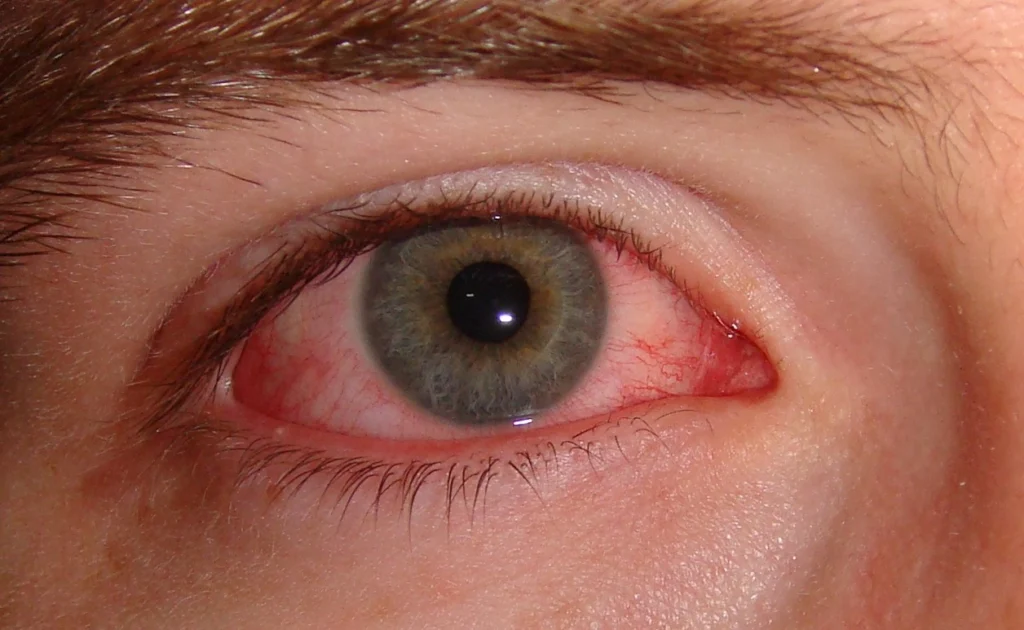Eye health is one area that frequently gets less attention than it deserves in the quest for optimal health. Redness and bloodshot eyes are among the numerous eye disorders that impact our daily function. Maintaining general health requires knowledge of red eye causes, symptoms, and treatments.
What is a Bloodshot eye?
A bloodshot eye is a medical term for the development of redness on the white portion of the eye (sclera). It is also referred to as a conjunctival injection. The dilated and more visible blood vessels on the surface of the eye cause this redness. It can range in severity from mild to severe and affects one or both eyes.
Causes of Red Eyes
It can result from numerous factors, ranging from environmental irritants to underlying health issues. Common causes include:
Allergies: Red, itchy eyes can result from allergic reactions brought on by dust, pollen, pet hair, and other irritants.
Dryness: This can cause eye redness and discomfort from inadequate tear production or excessive tear evaporation.
Eye Strain: Extended screen time, reading in dim light, or prolonged travel can lead to red eyes.
Infections: Inflammation and redness of the eyes can result from bacterial or viral infections, such as conjunctivitis (pink eye).
Environmental Factors: Redness and inflammation of the eyes might result from exposure to smoke, pollution, or harsh chemicals.
Symptoms of Red Eyes
Recognizing the signs and symptoms of red eyes is crucial to timely action and treatment. Among the symptoms could be:
Redness: Dilated blood vessels in the white portion of the eye give the appearance of bloodshots.
Itching or Irritation: Rubbed eyes that are itchy, gritty, or irritated tend to make them redder.
Crying: Watery eyes or excessive crying can occur in addition to redness, particularly as a reaction to allergens or irritants.
Discharge: When an infection occurs, the eyes may release a thick, watery, or purulent substance.
Sensitivity to Light: Photophobia, or light sensitivity, can accompany red eyes, particularly with inflammation or dry eye syndrome.
Stages and Severity Levels of Red Eyes
The degree of redness in the eyes can vary, going from subtle to rather noticeable. Even while some situations could seem concerning, they might not accurately represent the degree of discomfort felt. Many cases of redness in the eyes are benign and can be adequately treated with over-the-counter or home medicines.
If redness persists for over a week or is accompanied by pain or blurred vision, schedule an appointment with an eye care specialist like an ophthalmologist or optometrist. This is crucial as persistent redness or symptoms may indicate an underlying issue requiring treatment. Seeking prompt medical assessment can identify the redness’s cause and ensure appropriate treatment, especially for serious underlying conditions.
When to Seek Medical Attention
While home treatments can generally cure mild cases of red eyes, some symptoms should be seen by a doctor right away. Speak with a medical expert if you suffer from:
Severe Pain: Severe eye pain, especially with vision changes, could indicate a serious issue.
Vision Changes: For blurry, double, or sudden vision loss, consult an eye care professional immediately.
Persistent Symptoms: If home remedies don’t work, there may be an infection or underlying issue.
Injury or Trauma: Prompt medical help is essential for any eye trauma, including exposure to chemicals or foreign objects.
Remedies and Treatment Options
Treating the underlying cause of red eyes while offering symptomatic relief is part of managing the condition. Here are a few efficient cures and methods of treatment:
Artificial Tears: By reducing dryness and irritation, lubricating eye drops can relieve redness and pain.
Warm Compresses: Rubbing a warm compress over the eyes helps reduce swelling and encourage the flow of tears.
Antihistamines: Using topical or oral antihistamines helps lessen the itching and redness associated with allergies.
Steer Clear of Irritants: Limit exposure to smoking, allergies, and irritants to prevent worsening red eyes.
Hydration: Maintaining adequate tear production and avoiding dryness can be achieved by drinking lots of water and remaining hydrated.
Resting the Eyes: Get enough sleep and take breaks from screens to reduce eye strain and redness.

Preventive Measures
Preventing red eyes involves adopting various proactive measures to minimize exposure to triggers and maintain optimal eye health. Here are some strategies to prevent red eyes:
Maintain Good Hygiene: Wash hands frequently to prevent germs and viruses causing eye redness and infections.
Reduce Your Exposure to Irritants: Reducing your exposure to smoke, dust, pollen, and other environmental irritants can help prevent allergic reactions and eye irritation.
Protective Eyewear: Wear safety glasses or goggles during risky activities to prevent eye injuries.
Take Screen Breaks: To lessen eye strain from extended screen time, adhere to the 20-20-20 rule: every 20 minutes, take a 20-second break, and glance at anything 20 feet away.
Stay Hydrated: To keep your body hydrated and avoid dry eyes and the redness that goes along with it, drink lots of water.
Use Lubricating Eye Drops: To keep your eyes moist and lessen redness if you have dry eyes, use lubricating eye drops or over-the-counter artificial tears.
Handle Allergies: To reduce symptoms and avoid redness, if you suffer from allergies, try minimizing your exposure to allergens and thinking about using antihistamines or allergy treatments.
Follow Proper Contact Lens Care: Adhere to Your Eye Care Provider’s Instructions for Appropriate Cleaning, Disinfection, and Wearing Schedule if You Wear Contact Lenses: This will help you avoid irritation and redness.
Maintain a Healthy Lifestyle: To maintain general eye health and lower the risk of redness, eat a balanced diet high in vitamins and nutrients, exercise frequently, manage stress, and get enough sleep.
Frequent Eye Exams: Make an appointment for a routine eye checkup with an eye care specialist to keep an eye on the health of your eyes, identify any underlying disorders early, and get customized advice on how to avoid red eyes.
Risk Factors and Complications
It is crucial to see an eye expert as soon as possible if you experience red or bloodshot eyes because there are many possible causes of this condition, some of which are serious, and call for emergency care. If the redness appears abruptly and is accompanied by discomfort or blurred vision, this urgency is increased.
Without quick medical attention, several underlying diseases linked to red eyes pose a high risk of vision loss or injury to the eyes. Interestingly, redness in one eye but not the other may indicate a more serious problem with the eyes.
Vision loss, blindness, and irreversible eye damage are possible outcomes of conditions including glaucoma and eye trauma. It is imperative to seek expert examination and treatment as soon as possible to protect eye health and prevent complications, as red eyes may be a sign of vision-threatening disorders.
For more, read: Science Behind Compression Socks
Frequently Asked Questions (FAQs) about Red Eyes
Which virus results in bloodshot, red eyes?
Adenoviral conjunctivitis is a frequently occurring cause of acute ocular irritation. Additional diagnoses to take into account are conjunctivitis caused by the herpes virus, chlamydial conjunctivitis, allergic conjunctivitis, and several other less prevalent illnesses. Determining the viral cause might be aided by getting a thorough history.
What should I do if I wake up with red eyes in the morning?
If you wake up with red eyes, it could be due to various reasons, such as dryness, allergies, or eye strain. Try using lubricating eye drops and practicing good eye hygiene. If the redness persists or worsens throughout the day, seek medical advice.
Can over-the-counter eye drops treat red eyes effectively?
Over-the-counter eye drops can provide temporary relief for mild cases of red eyes caused by dryness or irritation. However, if redness persists or is accompanied by other symptoms, consulting an eye care professional is recommended.
Are red eyes always a cause for concern?
While red eyes can result from benign causes such as allergies or minor irritations, they can also be a sign of more serious underlying conditions. It’s essential to assess the accompanying symptoms and seek medical advice if necessary.
Conclusion
Maintaining optimal eye health is essential for overall well-being and quality of life. By understanding the causes, symptoms, and treatment options for red eyes, individuals can take proactive steps to alleviate discomfort and promote healing. From managing allergies to practicing good eye hygiene, incorporating these strategies into daily life can help prevent and manage redness, ensuring clear and comfortable vision for years to come.

